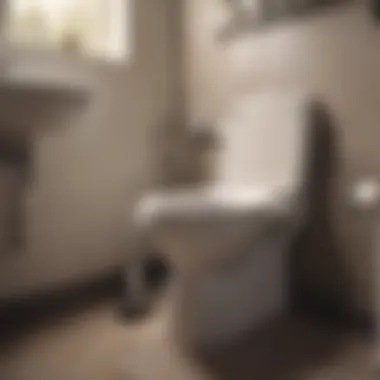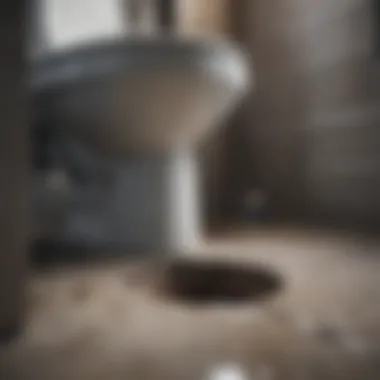Techniques to Unclog a Toilet Efficiently


Intro
Toilets play a critical role in the daily function of any home. However, clogs are a common issue that can lead to frustration and inconvenience. Whether it’s a minor blockage or a more serious problem, knowing how to address toilet clogs efficiently is essential.
This article explores various techniques to unclog a toilet effectively, offering methods and tools that can be useful in both immediate situations and for long-term maintenance. Readers will learn about the causes of toilet clogs and suitable strategies to ensure a functional toilet. Modern plumbing systems vastly improve convenience, but upkeep is still necessary to prevent issues.
Understanding how clogs occur is a valuable starting point. Often, clogs result from improper items being flushed, such as hygiene products or excessive toilet paper. Other potential culprits can include foreign objects unintentionally dropped into toilets or everyday wear and tear on plumbing components. By recognizing the signs of a clog early, readers can take timely action and avoid future problems.
In the sections that follow, we will cover various unclogging techniques, discuss essential tools, and share preventive measures to maintain toilet functionality. This understanding serves all homeowners, helping them manage their plumbing systems more adeptly.
Techniques to Unclog a Toilet
When faced with a clogged toilet, several techniques can be employed to restore normal function without causing damage. Below are some of the most effective methods:
Plunger Use
Using a plunger is often the first line of defense against a clog.
- Choose the right plunger: Use a flange plunger, which is designed for toilets, as it creates a better seal.
- Position it correctly: Ensure that the bell-shaped rubber head fully covers the drain hole.
- Push and pull: Apply force through a series of pushes and pulls. This action helps to dislodge the blockage.
- Flush the toilet: After a few attempts, try to flush. If water drains, you've successfully unclogged the toilet.
Toilet Auger
If plunging does not work, a toilet auger may be necessary. This tool reaches clogs that are deeper in the plumbing system.
- Insert the auger: Carefully feed the auger cable into the toilet until you feel resistance.
- Rotate the handle: Twisting the handle helps to bore through or snag the blockage.
- Retrieve the auger: Once the obstruction is removed, flush the toilet to clear any remnants.
Chemical Solutions
Chemical drain cleaners can also provide assistance but should be used with caution. Always read labels before using.
- Look for products designed specifically for toilets and follow the usage instructions.
- Avoid mixing chemicals, as this can create harmful reactions.
Preventive Measures
Maintaining a toilet helps to minimize clogs. Some preventive tips include:
- Use toilet-friendly products: Only flush items that are designed to be disposed of in a toilet.
- Regular maintenance: Perform periodic inspections to ensure components are functioning properly.
- Educate family members: Make sure everyone in the household knows what can and cannot be flushed.
In summary, knowing how to effectively unclog a toilet is valuable knowledge for homeowners. By being proactive and employing the right techniques and tools, individuals can maintain an efficient and clean bathroom environment.
Understanding Toilet Clogs
Understanding toilet clogs is essential for effective home plumbing management. Toilet clogs can lead to significant inconveniences and often require immediate attention to prevent further complications. Knowing the common causes of these clogs is the first step in preventing them. When you understand the underlying issues, you can avoid more serious plumbing problems in the long run.
Common Causes of Toilet Clogs
Paper products and excessive waste
Paper products, along with excessive waste, are frequently responsible for clogged toilets. Toilet paper is designed to break down in water, but when used in excess or combined with other waste, it can create a blockage. People often underestimate how much paper they flush, thinking it will dissolve quickly. However, large amounts can clump together and obstruct the pipes. This aspect certainly highlights a major contributing factor to clogging in both residential and commercial settings. Managing the amount of paper used is particularly beneficial for maintaining a smoothly functioning system.
Foreign objects
Foreign objects are another leading cause of toilet clogs. Items like toys, sanitary products, or other miscellaneous debris can accidentally find their way into the toilet bowl. When these objects are flushed, they can become lodged in the pipes, creating significant obstructions. The unpredictability of this issue makes it a notable concern. Ensuring that only appropriate objects go into the toilet can prevent a situation that requires intensive measures for removal.
Low water levels
Low water levels in a toilet can also lead to clogs. Toilets rely on a sufficient amount of water to flush waste effectively. If the water level in the tank is too low, the flush may not generate enough force to clear the bowl efficiently. This aspect directly links to how toilets operate and can affect their performance. Regularly checking and adjusting the water level is an important practice for preventing minor clogs from becoming major issues.
Signs of a Clogged Toilet
Slow draining
Slow draining is one of the first signs that a toilet may be clogged. When the water takes an unusually long time to clear from the bowl, it can indicate a buildup in the pipes. This characteristic can often suggest that something is obstructing the passage, which warrants immediate attention. Identifying slow drainage early can help prevent complete blockages, which are more difficult to resolve.


Unusual noises
Unusual noises, such as gurgling sounds or bubbling, may also indicate a clog. These sounds can signal that air is unable to flow freely through the plumbing system. This issue could relate to any buildup within the pipes or even problems in other fixtures. Recognizing these noises is crucial, as they often serve as an alert to potential plumbing issues that could escalate without intervention.
Water level fluctuations
Water level fluctuations in the bowl can signal impending trouble. If the water level rises too high or drops dramatically within a short period, this inconsistency may point to a blockage. Recognizing these fluctuations is important for maintaining a properly functioning toilet system. Addressing fluctuations sooner rather than later can help avoid more severe plumbing issues.
Immediate Solutions for Clogged Toilets
When a toilet becomes clogged, quick solutions are essential to restore functionality. Understanding immediate solutions is important for effective problem-solving. It saves time and prevents potential water damage or sanitation issues. Being adept at these strategies also empowers homeowners to handle situations independently, promoting confidence in managing household maintenance.
Using a Plunger
Selecting the right plunger
Choosing the appropriate plunger is vital for effective unclogging. There are two main types: the flange plunger and the cup plunger. The flange type has an extended rubber rim that seals better in the toilet bowl. This sealing capability helps to create effective pressure. In contrast, the cup plunger is more suited for sinks. Selecting the right one ensures better results when attempting to unclog the toilet. A flange plunger is typically the better choice when dealing with toilet clogs.
Plunging techniques
Proper plunging techniques are critical for achieving success. First, ensure there is enough water in the bowl to cover the plunger. This coverage allows the device to work correctly. Next, position the plunger over the drain hole and push down gently. Avoid aggressive slamming, as this can damage the toilet. Instead, use a firm but controlled thrusting motion. After several successful thrusts, pull the plunger back gently. This motion may help dislodge the blockage. If done correctly, this process can effectively clear the clog.
Safety precautions
Taking safety precautions is wise when unclogging toilets. Always wear rubber gloves to protect your hands. Toilets can harbor bacteria that may be harmful. Additionally, consider wearing safety goggles to shield your eyes from splashes or debris. If using harsh chemicals, ensure proper ventilation in the area. Implementing these precautions helps minimize health risks while maximizing cleaning efforts.
Employing a Toilet Auger
Purpose and functionality
A toilet auger serves as a powerful tool specifically designed for unclogging toilets. Unlike a plunger, it features a flexible cable that effectively reaches deeper blockages. The unique design allows the auger to navigate bends in the toilet’s plumbing. This flexibility is crucial when dealing with more severe clogs. Its purpose is to break through and remove obstructions that are otherwise inaccessible, making it an effective option for toilet maintenance.
How to use a toilet auger
Using a toilet auger requires a few steps for proper implementation. First, insert the end of the auger into the toilet bowl. Gently feed the cable into the drain. Turn the handle clockwise as you push forward; this motion helps to break up the clog. Continue until you feel resistance, which indicates you have reached the blockage. Once you’ve broken through, retract the cable slowly, ensuring any debris is removed.
Maintenance of the auger
Regular maintenance of the auger is essential for longevity and effectiveness. After each use, clean the cable thoroughly to remove any residue. Inspect the auger for any bends or damage that could affect performance. Store it in a dry area to prevent rust, especially on metallic components. Maintaining the auger properly enhances its reliability and ensures readiness for future unclogging challenges.
Chemical Treatments for Toilet Clogs
Understanding chemical treatments for toilet clogs is crucial for homeowners dealing with persistent drainage issues. This section will dive into the various types of drain cleaners available in the market and explore their benefits and potential risks. Knowing how to use these products effectively can make the difference between a successfully unclogged toilet and a plumbing nightmare.
Types of Drain Cleaners
Liquid vs. granular options
Liquid and granular drain cleaners are both common choices for dealing with toilet clogs. Liquid cleaners often dissolve clogs faster due to their consistency. They penetrate obstructions more easily, making them effective in many cases. However, liquid options can sometimes contain harsher chemicals which may be damaging to plumbing systems.
In contrast, granular types, while slower to act, provide a different mechanism for clearing clogs. They can be less harmful to pipes, as they tend to be formulated with gentler ingredients. It's crucial to evaluate specific situations when selecting between the two. Liquid cleaners can be effective in emergencies, while granular options might be better for routine maintenance.
Enzyme-based solutions
Enzyme-based solutions represent a more eco-friendly approach to clearing clogs. These cleaners use natural enzymes to break down waste and organic matter. They are a popular choice among individuals who prioritize environmental safety. One major characteristic of enzyme-based cleaners is their capacity to digest buildups over a period, promoting long-term cleanliness in pipes.
While generally safe for plumbing, enzyme cleaners may require more time to show results. They work best as preventive measures rather than instant fixes. Their unique advantage is the prevention of future clogs, but users should be aware that they may not be effective for all types of blockages.
Safe usage instructions
Safe usage of chemical cleaners is paramount to avoid accidents. Always read the label before using any product. Key instructions include wearing gloves and safety goggles to protect from spills. Additionally, it’s important to avoid mixing different types of cleaners, as this can lead to dangerous reactions.
Following the recommended amounts and application methods ensures the effectiveness of the product while minimizing risks. Safe usage helps reduce the potential for damage to plumbing and the surrounding environment. Proper application provides clearer drains while safeguarding personal health.
Potential Risks of Chemical Cleaners


Damage to plumbing
Using chemical cleaners can sometimes lead to damages in plumbing systems. Strong chemical reactions may corrode pipes, especially older ones made of specific materials. The high acidity or alkalinity in some cleaners can break down the structural integrity of the pipes over time.
This potential risk should not be taken lightly. For many homeowners, safer, less abrasive options are preferable to prevent costly plumbing repairs. It’s wise to be cautious about product selection based on the plumbing material in place.
Environmental concerns
Environmental impacts of chemical cleaners are another significant consideration. Many of these products contain harsh chemicals that can harm aquatic ecosystems if they are released into wastewater. Once in the environment, these substances can contribute to water pollution.
Choosing environmentally friendly options, like enzyme-based cleaners, can mitigate these issues. By considering the environmental ramifications, users support a cleaner planet while managing their plumbing efficiently.
Health precautions
Health precautions are vital when working with chemical cleaners. Exposure to powerful chemicals can cause skin irritation, respiratory issues, and eye damage. Proper ventilation during usage is necessary, especially in enclosed spaces like bathrooms.
Implementing good safety practices by using gloves and masks can minimize risks significantly. Ensuring that children and pets are kept away from chemical treatments is also essential in maintaining a safe environment while addressing clogging issues.
The effective and safe use of chemical treatments can greatly enhance the hygiene and functionality of your toilet system, but it must be done with caution.
By understanding both the benefits and risks associated with chemical treatments, you can make informed decisions on managing toilet clogs effectively.
Preventive Measures to Avoid Clogs
Toilet clogs can be an inconvenience in any household. Preventive measures are essential to avoid these disruptions. Understanding how to manage waste and maintain the toilet system can save time, money, and stress. By implementing specific practices, homeowners can significantly reduce the likelihood of clogs and keep their toilets functioning efficiently.
Proper Waste Disposal
Educating Household Members
Educating household members on proper toilet use is crucial. Each person should know what is appropriate to flush. Items like paper towels, feminine products, and other non-degradable materials should never enter the toilet. This education helps in reducing clogs and maintaining the plumbing system.
Realizing how shared responsibility contributes to a clean environment is key. When family members understand the impact of their actions, they are more likely to follow the rules. The downside is that educating everyone requires time and effort but its long-term benefits far outweigh the challenges.
Creating a Waste Disposal Plan
Creating a waste disposal plan is another effective strategy. This plan encourages developed routines regarding bathroom waste management. For instance, providing a designated bin for paper products can reduce the chances of items being flushed.
This organized system allows quick identification of waste materials. It also promotes better habits. However, implementing this plan may depend on individual attitudes toward waste management.
Alternatives to Toilet Disposal
Consideration of alternatives to toilet disposal can be fruitful. Using composting methods for organic matter, for example, reduces the burden on traditional plumbing systems. In these cases, alternative methods help to prevent overloads and subsequent clogs.
The main characteristic of this approach is its eco-friendliness. Homeowners can contribute to environmental sustainability. However, not everyone is aware or willing to make these changes, which may limit its adoption.
Routine Maintenance Practices
Regular maintenance is vital for ensuring toilet efficiency. Establishing consistent practices can lead to a smoother operation and fewer clogs.
Regular Inspections
Routine inspections should be performed to identify any potential issues early. Checking for leaks, running toilets, or other signs of wear can prevent minor problems from escalating. Regular inspections can foster a proactive approach to plumbing care.
The advantage lies in early detection and repairs, reducing costs over time. However, the drawback is that thorough inspections require time and technical knowledge.
Using Toilet-Safe Products
Using toilet-safe products is an effective practice for maintaining the toilet system. Cleaning products that are specifically formulated for toilets help prevent any damage to plumbing and ensure cleanliness.
Selecting these products can make an impact on the longevity of the plumbing. However, some consumers may not be aware of the difference between safe and harmful products, which can make this option challenging to navigate.
Monitoring Water Levels


Monitoring water levels is critical for effective toilet management. Water levels that are too low can cause inefficient flushes, while levels that are too high can lead to overflow. Regular checks can help ensure the toilet continues to operate optimally.
This practice allows homeowners to catch problems early. If the water level is consistently off, it may indicate a more significant plumbing issue. The challenge for many is remembering to do these checks regularly, which may not always happen in practice.
Maintaining a proactive approach toward toilet care can lead to a more functional and stress-free bathroom experience.
When to Call a Professional
Knowing when to seek help from a professional plumber is critical for effective toilet maintenance. Everyday clogs may be manageable with common tools and techniques; however, certain situations indicate that a professional's expertise is required. Recognizing these indicators can save time, money, and further damage to your plumbing system.
Indicators for Professional Help
Persistent clogs
Persistent clogs refer to situations where a toilet becomes repeatedly obstructed despite attempts to clear it. This pattern can suggest a more serious underlying issue, such as a blockage in the main sewer line. The key characteristic of persistent clogs is their recurring nature. If a toilet clogs multiple times within a short period, it could mean that the problem is not merely a one-off event.
The pursuit of professional assistance in these cases is crucial as ignoring the issue can lead to significant damage. A unique feature of persistent clogs is that they lead to plumbing backups, which can result in foul odors and potential flooding. The advantages of addressing persistent clogs with a professional include thorough cleaning and inspection of the plumbing system, ensuring that no more serious issues go unnoticed.
Multiple fixtures affected
When multiple fixtures in a home are affected, it signals a more systemic problem within the plumbing system. Indicators may include simultaneous backups in sinks, tubs, or other toilets. The key characteristic here is the interconnectedness of the plumbing; problems in one area can cascade into others. The state of multiple fixtures can indicate whether the home is experiencing broader drainage or sewer line problems.
Addressing these situations with a professional is beneficial, as they possess the necessary skills and tools to diagnose and resolve complex plumbing issues efficiently. A unique aspect to note is that this could denote serious plumbing malfunctions that might escalate if left unattended. The advantage of getting help early is minimizing overall repair costs by solving issues before they become more severe.
Unusual plumbing noises
Unusual plumbing noises can be a cry for attention from the plumbing system. Sounds such as gurgling, bubbling, or loud flushing may indicate air trapped in the pipes or deeper issues, such as blockages. The significant characteristic here is that noises often signal problems not visible at the surface level.
Seeking a professional’s help when these noises persist is wise, as they could lead to more significant issues over time. A unique feature of these sounds is that they often give clues about what is happening behind the walls and beneath the floors. By interpreting these signs correctly, a plumber can prevent costly repairs down the line, making early intervention through professional help advantageous.
Choosing a Plumbing Professional
Selecting a plumbing professional is a crucial step in effectively resolving plumbing issues. Careful consideration of who to hire can make the difference between a quick fix and a problematic experience. Knowing what to look for in a plumbing professional increases the likelihood of receiving quality service.
Research and recommendations
The process of finding the right plumber often begins with research and recommendations. Engaging friends or family for referrals can provide trustworthy insights into local services. The key characteristic of this approach is that personal experiences may shed light on the quality of service provided by different plumbers.
Researching online reviews or rating platforms also offers an excellent way to gauge the reputation of a plumbing service. A unique aspect of using recommendations is that one can gather multiple opinions, helping to make an informed choice based on shared experiences. In the end, having well-reviewed professionals reduces risks and sets expectations for service quality.
Assessing credentials
Before hiring a plumber, it is vital to assess their credentials. This includes checking if they are licensed, insured, and bonded. The key characteristic here is that proper credentials reflect a plumber’s professionalism and legitimacy. In many regions, working without proper licenses is illegal, making this an essential consideration.
A unique benefit of assessing credentials is that it establishes peace of mind. Knowing that a plumber has fulfilled necessary qualifications implies reliable service. It also ensures that you are safeguarded against potential damages during the process, as insurance offers recourse in case of accidents.
Evaluating estimates and services
When considering hiring a plumbing professional, evaluating estimates and service options is necessary. Obtaining multiple quotes not only helps budget for repairs but also indicates the range of services offered. The key characteristic here is transparency; understanding all costs provides clarity about what to expect financially.
A unique aspect of evaluating multiple estimates is that it allows homeowners to compare not just prices but also the details of services included. This leads to more informed decisions, ensuring value for money. Overall, being thorough in this step minimizes unpleasant surprises after the work begins, ultimately enhancing the satisfaction with the chosen plumbing services.
Finale
The conclusion serves as a vital aspect of this article on unclogging toilets efficiently. It synthesizes all the techniques and strategies discussed throughout, offering a clear understanding of how to effectively manage this common plumbing issue.
Summary of Techniques and Best Practices
This section summarizes the key strategies for dealing with toilet clogs, providing readers with actionable steps and valuable insights. By recalling the methods and their effectiveness, individuals can instill confidence and navigate this problem with ease.
Combining methods for efficiency
Combining various methods for unclogging toilets enhances efficiency in resolving issues. This approach allows individuals to tackle different types of clogs using suitable tools. For instance, one may start with a plunger and then use a toilet auger if necessary. The key characteristic of this combining strategy is flexibility, allowing homeowners to adapt their techniques based on the specific clog situation. The unique feature of employing multiple methods is that it addresses the root cause effectively, minimizing the chances of recurrence. However, excessive reliance on chemical treatments should be avoided due to potential harm to plumbing systems.
Long-term maintenance strategies
Long-term maintenance strategies are critical for preventing future clogs. Regular inspections of plumbing systems, monitoring for potential issues, and using toilet-safe products help maintain optimal functionality. The key characteristic of these strategies is proactive management of plumbing health. Utilizing these methods minimizes disruptive clogs and fosters a more reliable restroom experience. The unique aspect of long-term strategies lies in their preventive nature; however, they require consistent effort and awareness from household members.
Benefits of proactive management
Proactive management of toilet maintenance delivers significant benefits in terms of efficiency and cost-effectiveness. By identifying and addressing potential clog issues early, homeowners can avoid expensive repairs and the frustration that comes with persistent clogs. Moreover, a proactive approach encourages a better understanding of plumbing systems within the home. Key aspects of this management style include regular education for household members and a commitment to routine check-ups. The ability to respond to issues before they escalate into serious problems underscores the benefits of this approach in maintaining a functional and safe bathroom environment.







